At a Glance
Expert’s Rating
Pros
Build qualitySmooth User Experience
Cons
Steep PricePoor camera performance
Our Verdict
FrontRow is a camera for vlogging and live-streaming your daily activities, but $400 gets you a finely crafted wearable with a merely adequate camera.
FrontRow is a bold new camera design from Ubiquiti Labs, designed to be a high-end wearable that streams directly to live platforms. As a content producer at PCWorld and Macworld my days are a mix of shooting video, taking photos, and live-streaming. I love experimenting with new ways to capture unique ideas. The promise of a wearable camera has always intrigued me, especially if it’s easy to use and has a camera just as good as my smartphone.
After wearing FrontRow for a month, I can see how it’s trying to bring together a mix of features that isn’t offered anywhere else. But it’s doing so at a hefty price.
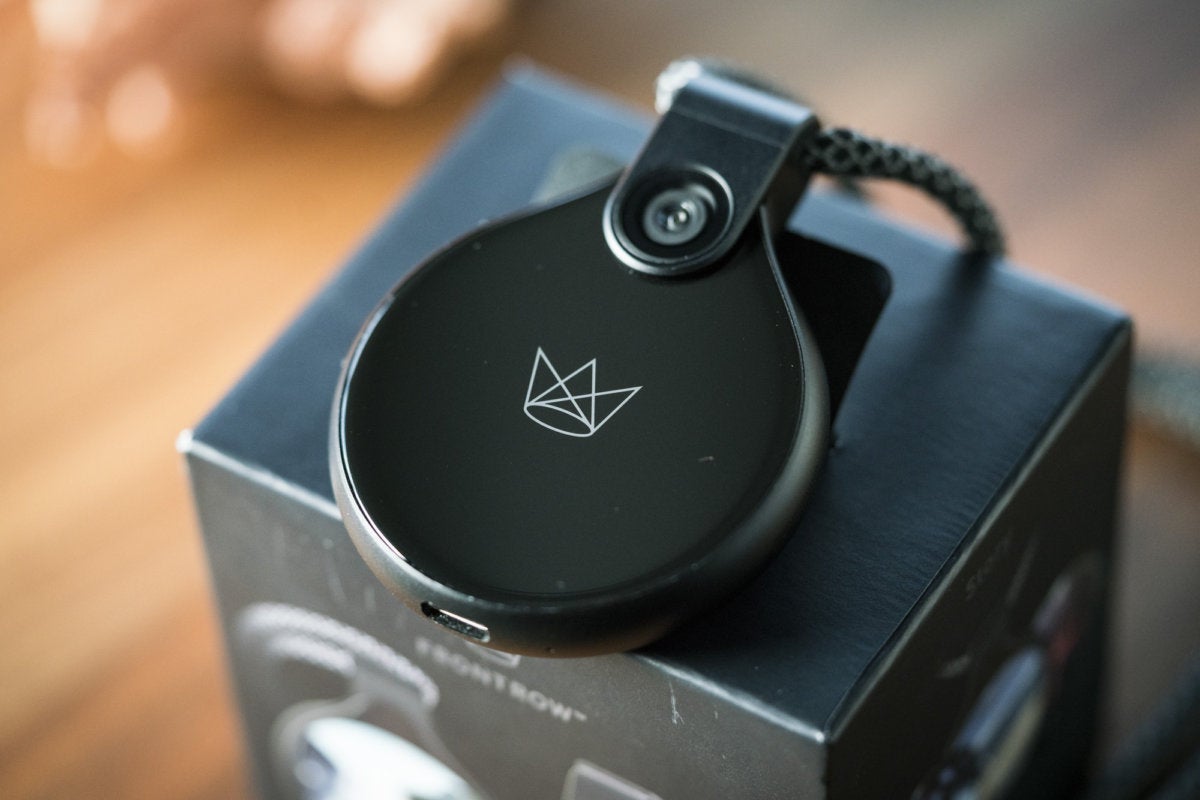 Adam Patrick Murray/IDG
Adam Patrick Murray/IDGThe design and build quality of the FrontRow is superb.
What is FrontRow?
FrontRow is a pendant-style wearable live-streaming camera, which is a mouthful to say. It isn’t an action cam like a GoPro, capturing your sick mountain biking trek. Nor is it like the long-dead Google Glass, mixing augmented reality into your life. It’s actually closer to Snapchat’s Spectacles and your smartphone itself. Featuring front- and rear-facing cameras, a 1.96-inch LTPS touchscreen, and running a stripped-down version of Android, this thing seems to have it all.
FrontRow also features a battery rated for 50 hours of standby time and just under 2 hours of recording or live-streaming time (which held true in testing). Stuffed inside is 32GB of non-upgradable storage (only 22GB usable), 2GB of RAM, and a quad-core processor. You recharge the device with an included USB-C cable.
FrontRow speaks to your phone via Bluetooth or Wi-Fi and interfaces with a fairly robust app. Once set up, it streams to one of three services: YouTube Live, Facebook Live, or Twitter Live (Periscope). FrontRow also takes photos, records video, or makes a time lapse with Story Mode. All of this can be triggered by button presses on its Media Button, on your phone, or on the device’s touch screen.
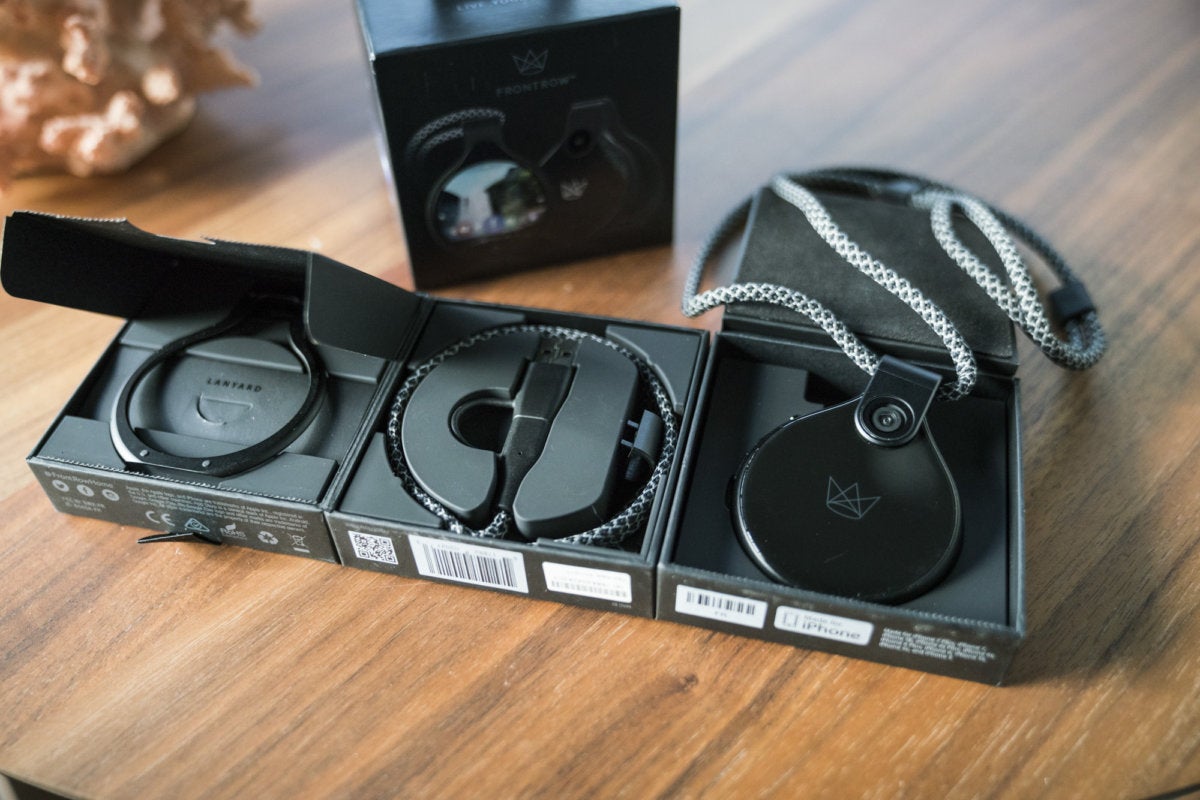 Adam Patrick Murray/IDG
Adam Patrick Murray/IDGOpening up the FrontRow package was a treat.
The design of the FrontRow is top-notch, and it feels solid. From the box it came in to the build materials, it screams high-end device. On the tip of the teardrop-shaped device is a clever mechanism for swapping mounts. In the box is an included felt necklace, a magnetic kickstand/clip, and a basic loop so you can add it to your existing necklaces. Ubiquiti Labs informed me that more mounting options are on the way, including a car window and flexible coil mount.
How was it to use?
With the nitty-gritty out of the way, let’s go over how it was to use. The FrontRow itself is pretty straightforward and painless from a technical perspective. The navigation on the touch screen is snappy, capturing a photo or starting a video with the button was always reliable, and even the onscreen keyboard proved to be usable.
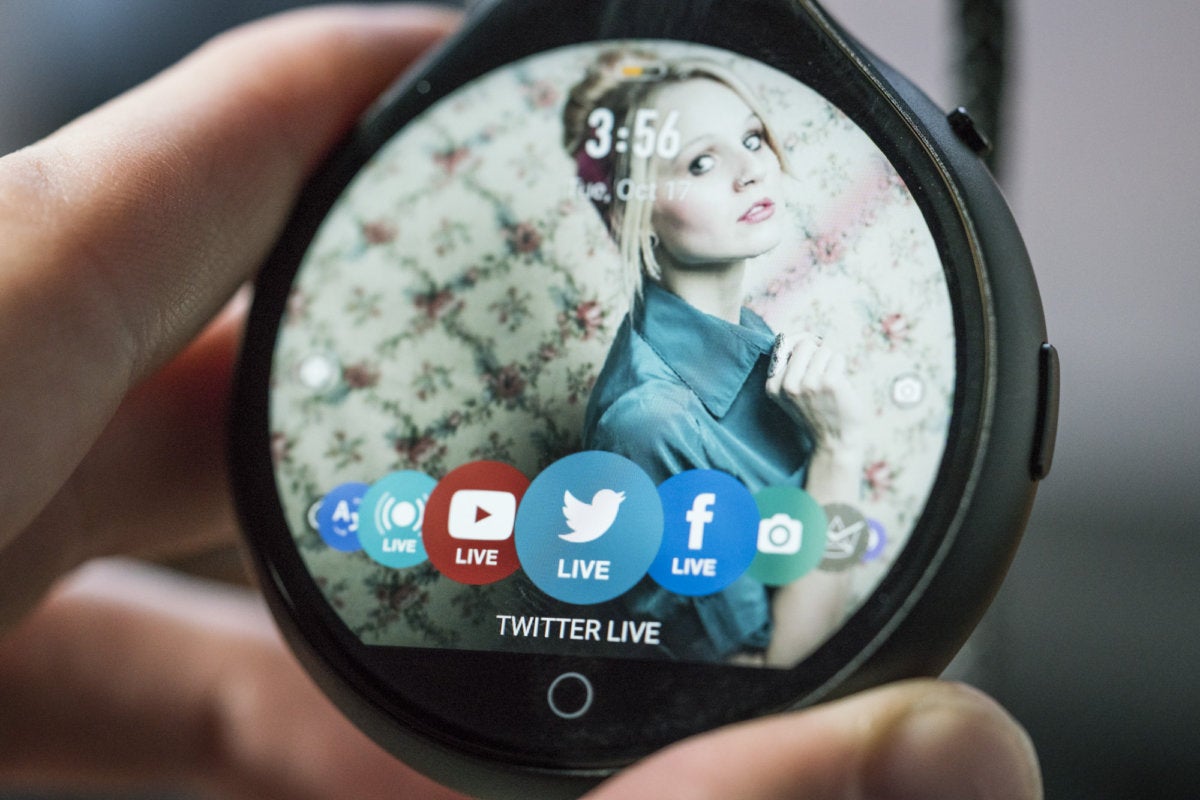 Adam Patrick Murray/IDG
Adam Patrick Murray/IDGThe home screen uses a carousel-style layout with a customizable wallpaper. Swipe down to reveal some quick settings, swipe left for the camera, and swipe right for the gallery.
A combination of vibrations and tones alerts you to what’s happening when you’re wearing the device. For example, pressing the Media Button once starts a countdown sequence for taking a photo, with each count giving a slight vibration. If you’re streaming to Facebook Live and lose connectivity, you hear a slight tone alerting you that the stream has stopped.
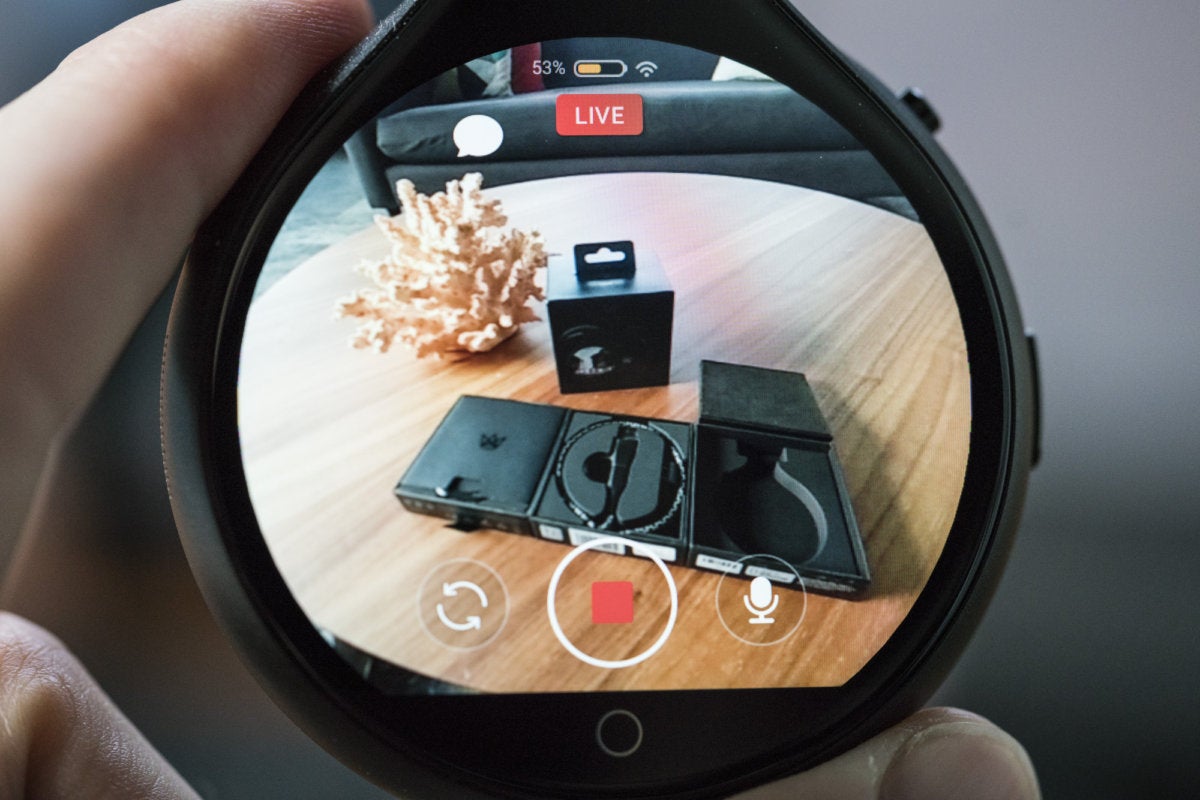 Adam Patrick Murray/IDG
Adam Patrick Murray/IDGSetting up and initiating a stream is painless no matter which service you go to.
Once connected to the phone, navigation inside the app is pretty straightforward, allowing access to the same functionality that’s on the device. Most of the time I was in the app to get pre-recorded footage onto my phone for posting later.
In a perplexing move, getting footage from the device onto a computer was not easy. I ended up having to sync all the footage and stills to my phone, let it sync to my Google Photos account, then download it locally to my laptop. Ubiquiti Labs intends for most people to share media straight from their phone, so they didn’t include the ability to mount it to a computer, but I think this is a mistake. Sure, I needed the footage on my computer so I can pixel-peep for this review, but there are plenty of other reasons why someone would need that access.
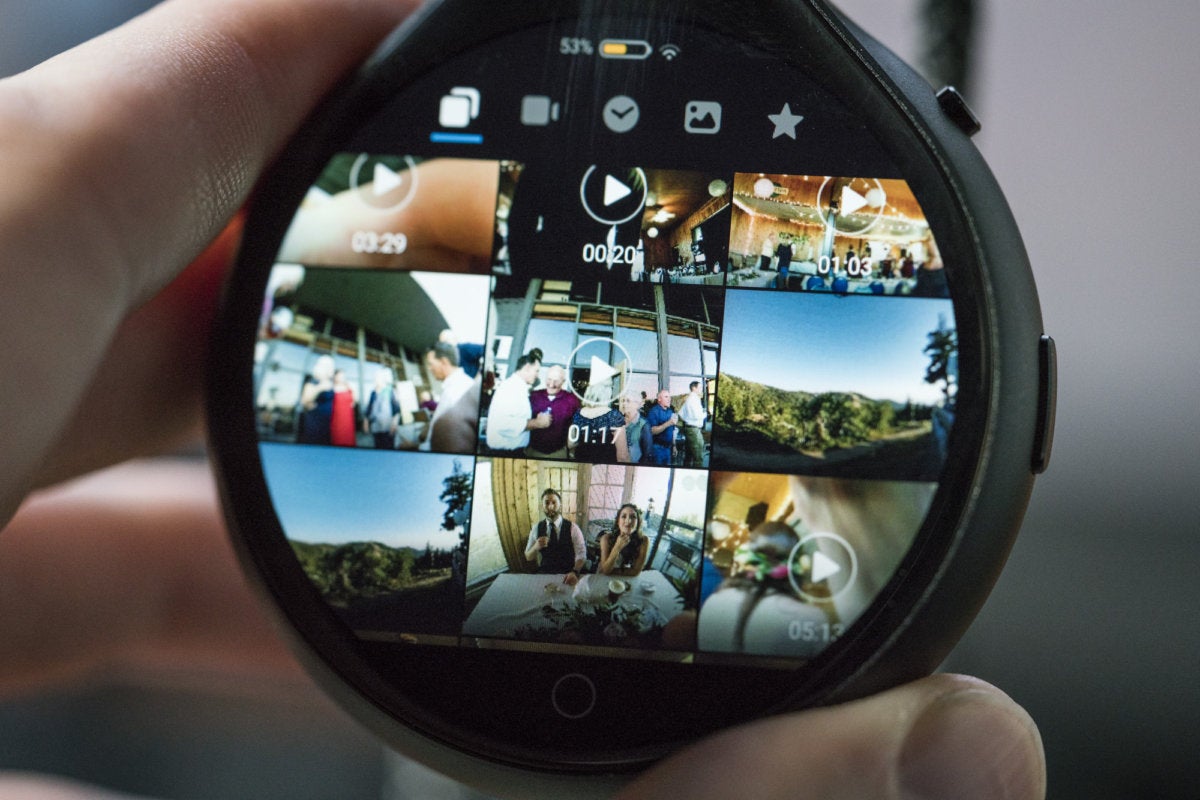 Adam Patrick Murray/IDG
Adam Patrick Murray/IDGThe touchscreen was bright and responsive, and the menu was fairly straightforward and easy to use.
What is the camera quality like?
I would’ve been willing to deal with the small quirks of using the FrontRow if the camera quality were as great as its design. The harsh truth is that it’s not. For a such a high-end device, it’s boggling that Ubiquiti Labs decided to use such a sub-par camera. The main sensor is the same 8MP Sony IMX 179 model used for the front-facing camera in last year’s Google Pixel. It’s a decent sensor, but I wanted something way better out of a $400 purchase.
 Adam Patrick Murray/IDG
Adam Patrick Murray/IDGDynamic range is limited: In this image, for intance, the sky is blown out and the dark areas are crushed.
 Adam Patrick Murray/IDG
Adam Patrick Murray/IDGIndoor scenes are not sharp, with lots of noise present in the shadows.
 Adam Patrick Murray/IDG
Adam Patrick Murray/IDGThere is even a noticeable amount of noise in the sky.
 Adam Patrick Murray/IDG
Adam Patrick Murray/IDGZooming in reveals an alarming amount of chromatic aberration, such as purple fringing. This is a weakness in the lens and shows up in most of the photos.
 Adam Patrick Murray/IDG
Adam Patrick Murray/IDGColors are fairly accurate, but nothing special.
The results show why. The sensor is paired with a f/2.2 lens touting a superwide field of view (around 148 degrees), and I don’t have much good to say about the quality. Colors are washed-out, the optical image stabilization is only passable, and there’s a hefty amount of chromatic aberration present in most lighting situations. Photos lack any sort of vibrancy or clarity, and have heavy amounts of noise present in anything other than brightly lit scenes. Despite such ho-hum captures, I did enjoy the included time lapse feature, which Ubiquiti Labs calls Story Mode.
Videos default to capturing at 1080p but can be recorded up 2.7K to take advantage of the wider field of view. I don’t know why you would, though, because the performance of the lens around the edges is horrible. Oh, and the microphone? Yeah, it’s tinny, weak, and applies very strong compression to the final output. In short, worthless.
Video quality for live-streaming needs to be great, because once a platform like Facebook Live is done compressing the hell out of it, you can still maintain a decent image. Unfortunately, because the quality coming out of the FrontRow is mediocre at best, compression makes it looks even worse. FrontRow also embeds its logo on any live broadcast. The official line is that the logo helps the community distinguish the superior performance of the FrontRow compared to other devices. This is in bad taste for many reasons and feels like a cheap way of getting the branding out there. In my eyes, if your product is that good, you don’t need to plaster your logo all over it—word of mouth will do it for you.
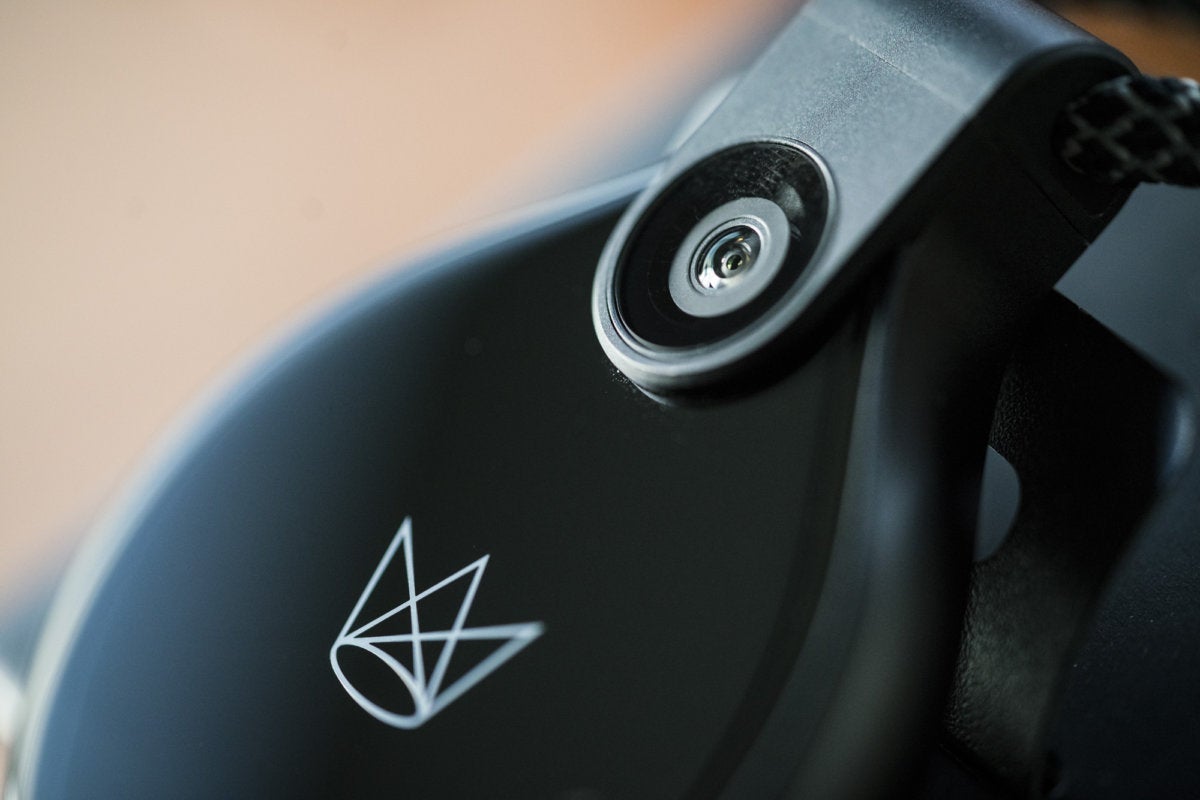 Adam Patrick Murray/IDG
Adam Patrick Murray/IDGThe camera on the FrontRow just doesn’t live up to the top notch design (and price).
Conclusion
There is plenty to love about the FrontRow, and I really wanted to give it praise. But no amount of great design, snappy performance, or sense of community can overcome the quality of its camera. This is an average sensor paired with a mediocre lens, with only basic processing done to the final output. The $400 price tag was already a tough sell on such a niche item, but the follow-through of camera performance is where Ubiquiti Labs ultimately fell short. The $400 is better spent on a good smartphone, or professional accessories for the one you have.